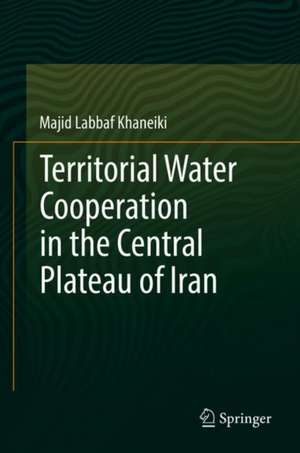Territorial Water Cooperation in the Central Plateau of Iran
Autor Majid Labbaf Khaneikien Limba Engleză Hardback – 20 noi 2018
This work gives insight into the indigenous adaptation strategies through the territorial water cooperation, and describes how water can appear as a ground for cooperation. It explains the water supply systems and social aspects of water in central Iran. Topics include the territorial water cooperation, qanat’s, the traditional water management and sustainability, the socio-economic context, the sustainable management of shared aquifers system and more.
Preț: 390.63 lei
Nou
Puncte Express: 586
Preț estimativ în valută:
74.76€ • 77.23$ • 62.22£
74.76€ • 77.23$ • 62.22£
Carte tipărită la comandă
Livrare economică 26 martie-09 aprilie
Preluare comenzi: 021 569.72.76
Specificații
ISBN-13: 9783030014933
ISBN-10: 3030014932
Pagini: 160
Ilustrații: X, 199 p. 53 illus., 34 illus. in color.
Dimensiuni: 155 x 235 mm
Greutate: 0.48 kg
Ediția:1st ed. 2019
Editura: Springer International Publishing
Colecția Springer
Locul publicării:Cham, Switzerland
ISBN-10: 3030014932
Pagini: 160
Ilustrații: X, 199 p. 53 illus., 34 illus. in color.
Dimensiuni: 155 x 235 mm
Greutate: 0.48 kg
Ediția:1st ed. 2019
Editura: Springer International Publishing
Colecția Springer
Locul publicării:Cham, Switzerland
Cuprins
Chapter 1: Introduction.- Chapter 2: Water Supply Systems in Central Iran.- Chapter 3: Social Aspects of Water in Central Iran.- Chapter 4- Cain and Abel in the Heaven of Water Cooperation.- Chapter 5- Cooperation in Lieu of Water.- Chapter 6: Conclusion.
Notă biografică
Majid Labbaf Khaneiki, UNESCO-ICQHS (International Center on Qanats and Historic Hydraulic Structures), Yazd, Iran
Textul de pe ultima copertă
This book tries to answer the question how different communities in such an arid area as the Iranian central plateau could have shared their limited water resources in a perfect harmony and peace over the course of history. They invented some indigenous technologies as well as cooperative socio-economic systems in order to better adapt themselves to their harsh environment where the scarce water resources had to be rationed among the different communities as sustainably as possible. Those stories hold some lessons for us on how to adjust our needs to our geographical possibilities while living side by side with other people. This work gives insight into the indigenous adaptation strategies through the territorial water cooperation, and describes how water can appear as a ground for cooperation. It explains the water supply systems and social aspects of water in central Iran. Topics include the territorial water cooperation, qanat’s, the traditional water management and sustainability, the socio-economic context, the sustainable management of shared aquifers system and more.
Caracteristici
Explains how water can appear as a ground for cooperation rather than the matter of war Clarifies the role of the socio-economic structures in preventing any conflict and tension over the shared water resources among the local communities in the central plateau of Iran Gives insight into the indigenous adaptation strategies through the territorial water cooperation Indicates how modernity can unbalance the relationship between the local communities and their shared water resources, contributing to the on-going water crisis
